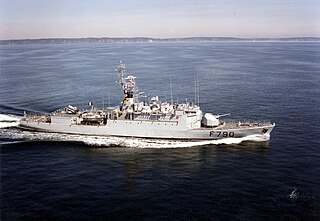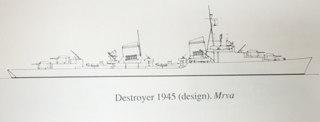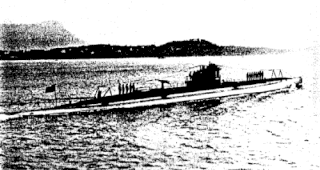Related Research Articles

The Type 212A is a class of diesel-electric submarine developed by Howaldtswerke-Deutsche Werft AG (HDW) for the German Navy, and the Italian Navy where it is known as the Todaro class. It features diesel propulsion and an additional air-independent propulsion (AIP) system using Siemens proton-exchange membrane (PEM) compressed hydrogen fuel cells. The submarines can operate at high speed on diesel power or switch to the AIP system for silent slow cruising, staying submerged for up to three weeks with little exhaust heat. The system is also said to be vibration-free and virtually undetectable.

The V-boats were a group of nine United States Navy submarines built between World War I and World War II from 1921 to 1934 under authorization as the "fleet boat" program.
Air-independent propulsion (AIP), or air-independent power, is any marine propulsion technology that allows a non-nuclear submarine to operate without access to atmospheric oxygen. AIP can augment or replace the diesel-electric propulsion system of non-nuclear vessels.

The D'Estienne d'Orves-class avisos, also known as the A69 type avisos, is a class of avisos, comparable in size to a light corvette, mainly designed for coastal anti-submarine defence, but are also available for high sea escort missions. Built on a simple and robust design, they have an economical and reliable propulsion system which allows them to be used for overseas presence missions. They were initially intended for use by the French Navy, but have been ordered by the South African Navy, Argentinian Navy and Turkish Navy.

MILGEM project (Turkish:Milli Gemi Projesi, English: National Ship Project) is a national warship program of the Republic of Turkey. Managed by the Turkish Navy, the project aims at developing multipurpose corvettes, frigates and destroyers that can be deployed in a range of missions, including reconnaissance, surveillance, early warning, anti-submarine warfare, surface-to-surface and surface-to-air warfare, and amphibious operations.
B-90 Sarov also referred to as Sarov class, Russian designation Project 20120 Sargan, is a Russian special purpose diesel-electric submarine that uses a nuclear reactor as a supplementary power generator. The existence of the submarine was first revealed in 2007, when details about the boat were accidentally published on the Sarov, Nizhny Novgorod region's local government website as part of an account of a meeting with its commander. It serves in the Russian Navy's Northern Fleet and is being used as a technology demonstrator for testing of upgraded weapons and military equipment or as an intelligence collection boat.

The Sjöormen class was a class of submarines built for the Swedish Navy in the late 1960s. They had a teardrop hull shape and were capable of diving to 150 metres (490 ft). At the time of their deployment they were regarded as one of the most advanced non-nuclear submarine-classes in the world, incorporating many new features including x-rudder and anechoic tiles. Both speed and underwater endurance was at this time very high for a conventional submarine. The submarines were retired by Sweden in the early 1990s. In the late 1990s, four submarines were acquired by the Republic of Singapore Navy (RSN) and relaunched as the Challenger class following modernisation and tropicalisation.
The S-99 experimental submarine was the only ship of the Project 617 class that the Soviet Union built during the early Cold War. She was the only Soviet submarine which used a German Walter turbine fueled by high-test peroxide (HTP). Entering service in 1956, the boat was assigned to a training unit of the Baltic Fleet. S-99 was badly damaged by a HTP explosion in 1959 and was not repaired. The submarine was decommissioned in 1964 and subsequently scrapped.

The Kalvari-class submarines, formally classified as the Project-75 submarines (P-75), is a class of diesel-electric attack submarines operated by the Indian Navy (IN). Currently being constructed by a syndicate of French and Indian shipyards, namely, Naval Group and Mazagon Dock Limited (MDL) respectively, the class is an export derivative of the French-origin Scorpène-class submarine, originally designed by Naval Group.

The Cheonghaejin class is a submarine rescue ship class of the Republic of Korea Navy. Only one ship has been built in the class, ROKS Cheonghaejin, in 1995. Its operations include rescuing trapped sailors in submarines, naval operation support for submarines, underwater research and mapping support, and recovery of sunk vessels. It is equipped with a deep submergence rescue vehicle (DSRV) that operates up to 500 metres (1,600 ft), and a rescue chamber that holds up to nine people.

Velebit was a modified Una-class midget submarine and the only submarine to see service with the Croatian Navy. It was built for the Yugoslav Navy during the 1980s where it was named Soča. At the outbreak of the Croatian War of Independence Soča was being overhauled in the Brodogradilište specijalnih objekata division of Brodosplit shipyard in Split, Croatia. Although stripped of all equipment, it was preserved from the retreating Yugoslav forces by the shipyard workers.

The French submarine Mariotte was a submarine built for the French Navy prior to World War I. Intended to accompany the fleet, she was designed for high speed on the surface. Although the navy was unsatisfied with her performance on the surface, the boat had a higher underwater speed than any French submarine before or during the following 35 years. Mariotte was plagued with engine problems during her construction and the navy spent years fixing the various issues before finally commissioning her five years after beginning construction. During the war, she participated in the Dardanelles Campaign, but had to be scuttled after she became entangled in the cables of a minefield on her first attempt to penetrate the Dardanelles.

Amiral Bourgois was one of four experimental submarines ordered for the French Navy in 1906. Each boat was built to a different design and Amiral Bourgois was intended to test a novel powerplant. The experimental diesel engines took over six years to build and greatly delayed the boat's completion until 1913. Although engine problems plagued the submarine throughout her service, she was commissioned shortly after the start of the First World War in 1914, but never made an operational patrol. Amiral Bourgois was under repair when the war ended in 1918, but the work was cancelled shortly afterwards. The boat was struck the following year and offered for sale in 1920. There were no offers and she was used for torpedo testing in 1924–1926. The submarine was sold for scrap in 1927.

The Type 1945 destroyers were a planned class of destroyers, for the Kriegsmarine, whose design was based upon that of the Type 1936D and E destroyers. Their plan involved a return to steam boilers, which had been replaced by diesel engines in all ships designs after the Type 1942 destroyers. No ships were ever built, as the end of the war was rapidly approaching.

The KSS-III or Dosan Ahn Changho-class is a series of diesel-electric attack submarines currently being built for the Republic of Korea Navy (ROKN), jointly by Hanwha Ocean and HD Hyundai Heavy Industries (HHI). The KSS-III is the final phase of the Korean Attack Submarine program, a three-phased program to build 27 attack submarines for the ROKN, between 1994–2029.

The French submarine Laplace (Q111) was a Lagrange-class submarine built for the French Navy built between 1913 and 1919. It was laid down in the Arsenal de Rochefort shipyards and launched on 12 August 1919. Laplace was completed in 1921 and served in the French Marine Nationale until 1935.

The French submarine Regnault (Q113) was a Lagrange-class submarine built for the French Navy built between 1913 and 1924. It was laid down in the Arsenal de Toulon shipyards and launched on 25 June 1924. Regnault was completed in 1924 and served in the French Marine Nationale until 1937.

The French submarine Romazotti (Q114) was a Lagrange-class submarine built for the French Navy built between 1914 and 1918, during World War I. It was laid down in the Arsenal de Toulon shipyards and launched on March 31, 1918. Romazotti was completed in 1918 and served in the French Marine Nationale until 1937.

Achille was a French Navy Redoutable-class submarine of the M6 series commissioned in 1933. She participated in World War II until she was scuttled in June 1940.

Le Tonnant was a French Navy Redoutable-class submarine of the M6 series commissioned in 1937. She participated in World War II, first on the side of the Allies from 1939 to June 1940, then in the navy of Vichy France. She was scuttled in November 1942.
References
- 1 2 Forster, Ed (2 January 2022). "Turkey Sells Mini-Submarine STM500 After the Commercial Success of Bayraktar Combat Drones; These Cheaper Weapon Systems Are More Affordable". Headlines & Global News. Retrieved 27 June 2022.
- ↑ "www.stm.com.tr".